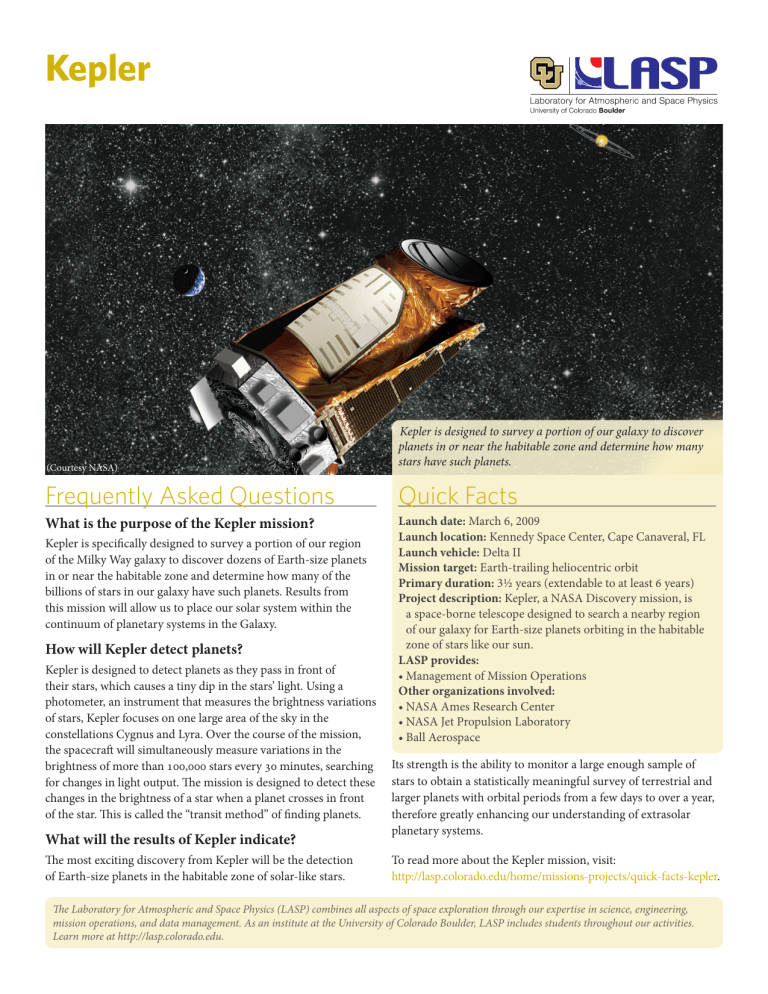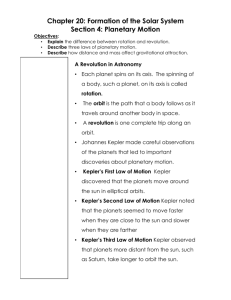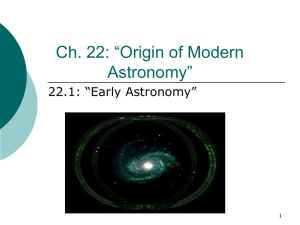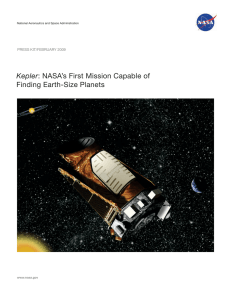Kepler

Kepler
(Courtesy NASA)
Frequently Asked Questions
What is the purpose of the Kepler mission?
Kepler is specifically designed to survey a portion of our region of the Milky Way galaxy to discover dozens of Earth-size planets in or near the habitable zone and determine how many of the billions of stars in our galaxy have such planets. Results from this mission will allow us to place our solar system within the continuum of planetary systems in the Galaxy.
How will Kepler detect planets?
Kepler is designed to detect planets as they pass in front of their stars, which causes a tiny dip in the stars’ light. Using a photometer, an instrument that measures the brightness variations of stars, Kepler focuses on one large area of the sky in the constellations Cygnus and Lyra. Over the course of the mission, the spacecraft will simultaneously measure variations in the brightness of more than 100,000 stars every 30 minutes, searching for changes in light output. The mission is designed to detect these changes in the brightness of a star when a planet crosses in front of the star. This is called the “transit method” of finding planets.
What will the results of Kepler indicate?
The most exciting discovery from Kepler will be the detection of Earth-size planets in the habitable zone of solar-like stars.
Kepler is designed to survey a portion of our galaxy to discover planets in or near the habitable zone and determine how many stars have such planets.
Quick Facts
Launch date: March 6, 2009
Launch location: Kennedy Space Center, Cape Canaveral, FL
Launch vehicle: Delta II
Mission target: Earth-trailing heliocentric orbit
Primary duration: 31/2 years (extendable to at least 6 years)
Project description: Kepler, a NASA Discovery mission, is a space-borne telescope designed to search a nearby region of our galaxy for Earth-size planets orbiting in the habitable zone of stars like our sun.
LASP provides:
• Management of Mission Operations
Other organizations involved:
• NASA Ames Research Center
• NASA Jet Propulsion Laboratory
• Ball Aerospace
Its strength is the ability to monitor a large enough sample of stars to obtain a statistically meaningful survey of terrestrial and larger planets with orbital periods from a few days to over a year, therefore greatly enhancing our understanding of extrasolar planetary systems.
To read more about the Kepler mission, visit: http://lasp.colorado.edu/home/missions-projects/quick-facts-kepler .
The Laboratory for Atmospheric and Space Physics (LASP) combines all aspects of space exploration through our expertise in science, engineering, mission operations, and data management. As an institute at the University of Colorado Boulder, LASP includes students throughout our activities.
Learn more at http://lasp.colorado.edu.










